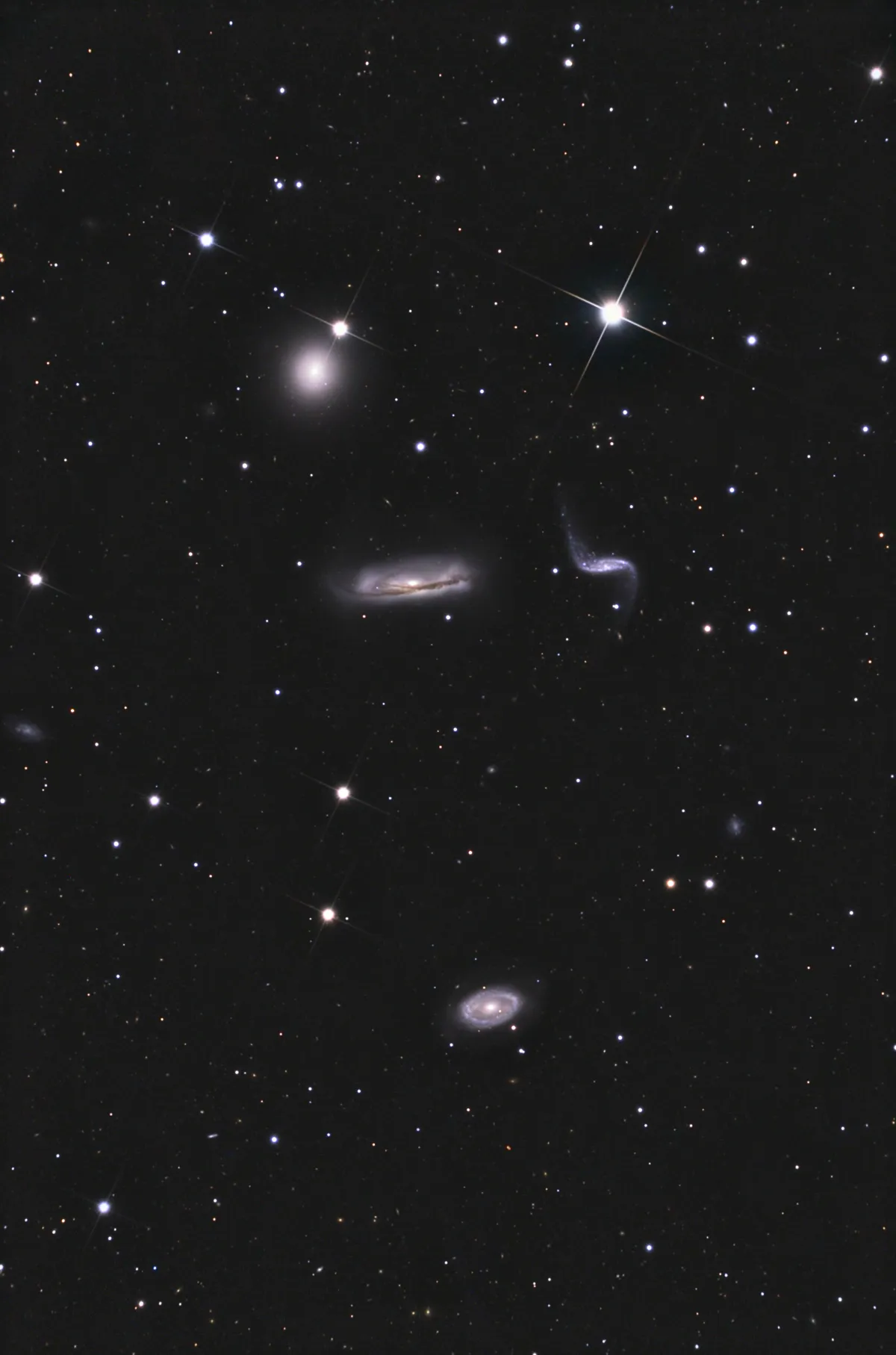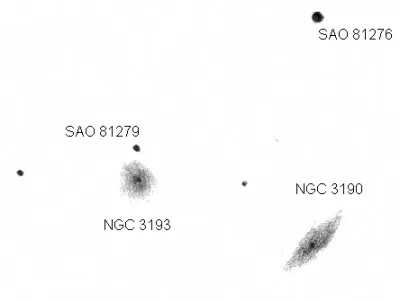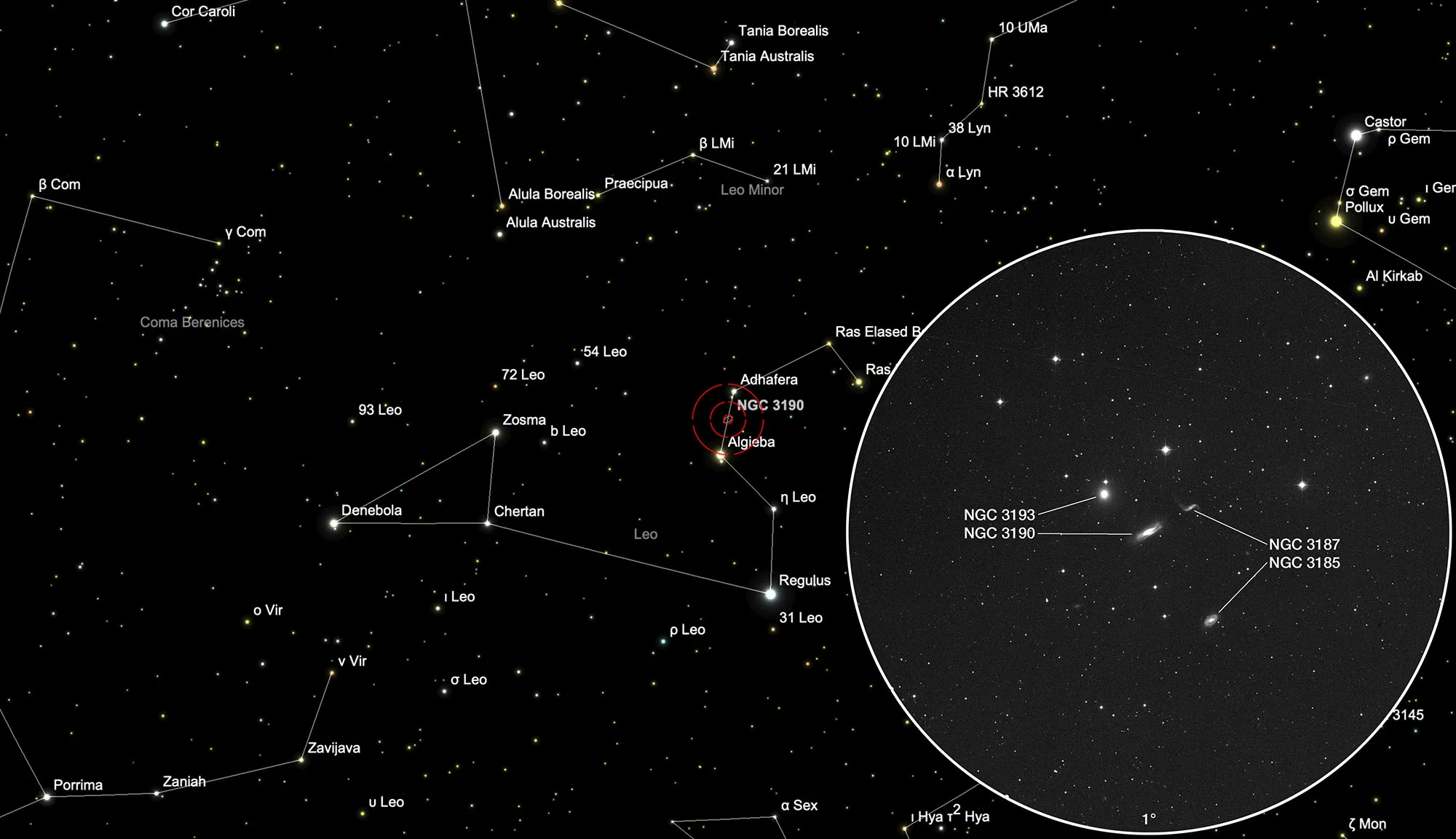Galaxy Group Hickson 44

History
The galaxy group Hickson 44 has four members: NGC 3190 and NGC 3193 are the two brightest galaxies in the group and were discovered on 12 March 1784 by William Herschel discovered with his 18.7 inch reflector telescope and cataloged as II 44 and II 45. He noted for both: «Two. both faint, extended, a little brighter much in the middle, resolvable» [463]
In January 1850, the Irish astronomer and physicist George Stoney, in Birr Castle, Ireland, pointed the huge 72-inch reflector «Leviathan» of his employer William Parsons, 3rd Earl of Rosse, at this region of the sky and discovered three other galaxies: NGC 3185, NGC 3187 and NGC 3189. The following description of the latter can be found in John L. E. Dreyer's NGC catalog: "very very faint, much extended, parallel to h 692" (h 692 = NGC 3190). Presumably he was irritated by the dust band of this galaxy. [313]
Physical Properties
With a Hubble constant of 75 km/s/Mpc, the group is about 60 million light years away. The other galaxies of this cluster can already be seen in one and the same field of view in medium to large amateur telescopes.
The galaxy NGC 3185 has a bar structure with an outer ring. So it looks a bit like a large Greek theta (Θ). In the group of the four galaxies, it is the second weakest member with a visual brightness of 12.2 mag and a surface brightness of 12.8 mag. In terms of dimensions, however, it is the smallest. Its axis of rotation is inclined by 56 degrees against the line of sight and it moves away from the centre of the local group at a speed of about 1100 km/s. With a Hubble constant of 75 km/s/Mpc, NGC 3185 is about 48 million light years away. [134]
NGC 3187 is a distinctive barred spiral galaxy in shape and looks a bit like an integral sign. It has a visual brightness of 13.4 mag and a surface brightness of 14.9 mag. Thus it is the weakest member of this group of galaxies. The axis of rotation is inclined at 69 degrees. [134]
NGC 3190 is a spiral galaxy of the Hubble type Sa, i. e. the spiral arms are wound relatively tightly around the large central area. We don't see the galaxy from the very edge, around 8 degrees are missing. Astronomers on one of the planets in this distant star system would be looking at the 50-degree inclined disk of our Milky Way. In this group of galaxies it is the second brightest galaxy with a visual brightness of 11.2 mag, but has the largest angular extent with 4.1x1.6 arc minutes. The axis of rotation is inclined by 75 degrees. [134]
The galaxy NGC 3193 is an elliptical galaxy with an almost spherical shape. It has a visual, integrated brightness of 10.9 mag and a surface brightness of 12.7 mag. It appears to us with an angular extension of 2.5 arc minutes. The angle between its axis of rotation and our line of sight is about 32 degrees and it is about the same distance from us as NGC 3190. [134]
| Name | RA | Dec | Type | bMag | vMag | B-V | SB | Dim | PA | z | D(z) | MD | Dreyer Description | Identification, Remarks |
|---|---|---|---|---|---|---|---|---|---|---|---|---|---|---|
| NGC 3185 | 10 17 38.4 | +21 41 19 | Gx (SBa) | 13.0 | 12.2 | 0.8 | 13.4 | 2.1 × 1.4 | 130 | 0.004060 | 17.15 | 22.000 | pF, pL, gmbM | GC 2054; UGC 5554; MCG 4-24-24; CGCG 123-34; HCG 44C; IRAS 10148+2156 |
| NGC 3187 | 10 17 47.7 | +21 52 26 | Gx (SBc/P) | 13.9 | 13.4 | 0.5 | 14.7 | 3.6 × 1.6 | 57 | 0.005274 | 22.28 | 26.100 | vF, E | GC 2055; UGC 5556; MCG 4-24-25; CGCG 123-36; IRAS 10150+2207; Arp 316; VV 307; HCG 44D |
| NGC 3189 | 10 18 04.2 | +21 49 56 | GxyP | 23.630 | vvF, mE, parallel to h 692 | GC 2057; part of N 3190 | ||||||||
| NGC 3190 | 10 18 05.6 | +21 49 58 | Gx (Sa) | 12.1 | 11.2 | 0.9 | 13.1 | 4.4 × 1.5 | 125 | 0.004240 | 17.91 | 23.630 | B, pS, E, psbMN | WH II 44; h 692; GC 2058; UGC 5559; MCG 4-24-26; Arp 316; IRAS 10153+2204; CGCG 123-37; VV 307; HCG 44A |
| NGC 3193 | 10 18 24.8 | +21 53 38 | Gx (E2) | 11.8 | 10.9 | 0.9 | 13.2 | 2 × 2 | 0.004667 | 19.71 | 29.560 | B, S, vlE, pslbM, * 9.5 354°, 80" | WH II 45; h 693; GC 2061; UGC 5562; MCG 4-24-27; CGCG 123-38; Arp 316; VV 307; HCG 44B |
Finder Chart
The galaxy group lies in the head of Leo, between the well-known double star Gamma Leonis (Algieba) and the 3.4 mag star Zeta Leonis (Aldhafera). So it's extremely easy to find! On 22 February it is in opposition to the Sun and crosses the meridian at local midnight.
Visual Observation

200 mm Aperture: The galaxy group looks most beautiful in an eyepiece with medium magnification and a relatively large field of view. The brightest star in the field of view is SAO 81276 with 7.8 mag, the second brightest SAO 81279 with about 9 mag.
Of the three visible of the four galaxies, NGC 3185 is the faintest. It could almost only be seen indirectly and therefore showed no structures. Even in the 10 inch telescope, the view of this galaxy is about the same. It is not entered in the drawing.
A few arc minutes south of the 7.8 mag star you come across the elongated galaxy NGC 3190. At first glance, it looks almost like an edge-on galaxy. You think you can see the dust band as a thin line. But it is not as clear as that of the galaxy NGC 891 in Andromeda for example. The brightness distribution appears relatively even, except that the centre makes a stellar impression. NGC 3190 is the most pronounced, if only the second brightest of the visible trio.
NGC 3193 is only 50 arc seconds south of the 9 mag star. It is the brightest galaxy in this cluster, but it does not show much structure and appears more like a round blob. The star-shaped core is also striking here. As it should be for an elliptical galaxy, the brightness is mainly concentrated in the inner area and then continuously decreases towards the outside.
